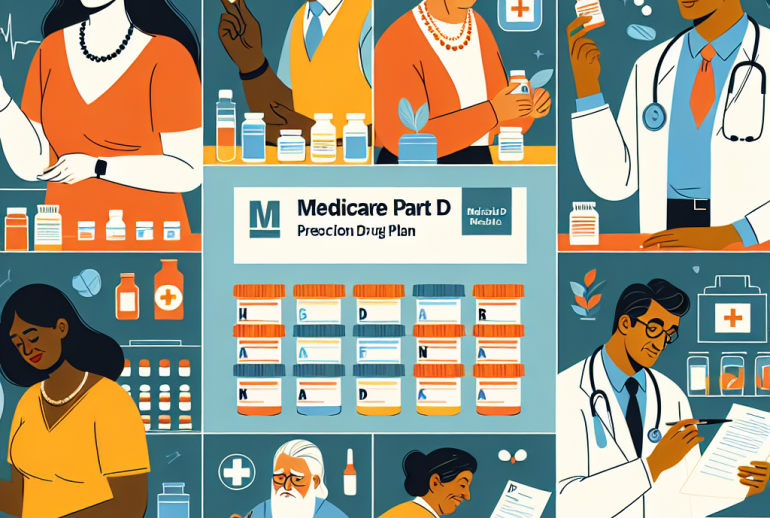Understanding the Medicare Part D Prescription Drug Plan
As we age, managing our healthcare becomes increasingly critical, and prescription medications often play a pivotal role in maintaining our quality of life. Medicare Part D is a federal program designed to help Medicare beneficiaries cover the cost of prescription drugs. However, understanding the intricacies of this plan can be daunting. This post aims to demystify the Medicare Part D Prescription Drug Plan, offering you a comprehensive guide to making informed decisions about your healthcare.
What is Medicare Part D?
Medicare Part D is an optional prescription drug coverage plan for individuals who are eligible for Medicare. Established under the Medicare Prescription Drug, Improvement, and Modernization Act of 2003, Part D is designed to subsidize the costs of prescription drugs and prescription drug insurance premiums for Medicare beneficiaries.
Enrolling in Medicare Part D is voluntary, with coverage provided through private insurance companies approved by Medicare. These plans work either as stand-alone Prescription Drug Plans (PDPs) or as part of Medicare Advantage Plans (MA-PD).
Eligibility for Medicare Part D
To enroll in a Medicare Part D plan, you must first be eligible for Medicare. This typically includes individuals who are:
- 65 years or older
- Under 65 with certain disabilities
- Any age with End-Stage Renal Disease (ESRD)
Once you meet Medicare eligibility, you need to enroll in either Medicare Part A (Hospital Insurance) or Medicare Part B (Medical Insurance) to qualify for Part D. It’s essential to be aware of the specific enrollment periods and associated penalties for late enrollment in a Part D plan.
How to Enroll in Medicare Part D
Enrolling in Medicare Part D involves several critical time periods:
1. Initial Enrollment Period (IEP)
This is the first chance you have to enroll in a Medicare Part D plan. It starts three months before your 65th birthday, includes the month of your birthday, and ends three months after your birthday month. If you delay enrollment beyond this period without other credible drug coverage, you may face a late enrollment penalty.
2. Annual Enrollment Period (AEP)
Occurring from October 15 to December 7 each year, the Annual Enrollment Period allows you to enroll in or switch Part D plans. Any changes made during this period take effect on January 1 of the following year.
3. Special Enrollment Period (SEP)
This period is available under specific circumstances, such as moving out of your plan’s service area, losing other prescription drug coverage, or qualifying for Extra Help (a program to assist individuals with limited income and resources).
Costs Associated with Medicare Part D
Understanding the costs associated with Medicare Part D is crucial to selecting the right plan for your needs. Here are the key components of Part D costs:
1. Monthly Premium
Each Medicare Part D plan has a monthly premium, which varies depending on the plan you choose and your location.
2. Annual Deductible
Before your plan starts to pay its share of your prescription drug costs, you may need to pay an annual deductible. In 2023, the maximum deductible allowed by Medicare is $505, but some plans may have lower or no deductible.
3. Copayments and Coinsurance
After you meet your deductible, you will pay a share of your prescription costs in the form of copayments (a set dollar amount per prescription) or coinsurance (a percentage of the cost).
4. Coverage Gap (Donut Hole)
Once your total drug costs reach a certain limit, you enter the coverage gap, commonly known as the “donut hole.” During this phase, you may pay higher out-of-pocket costs for your prescriptions until you reach the out-of-pocket spending limit.
5. Catastrophic Coverage
After surpassing the out-of-pocket spending limit during the coverage gap, you enter catastrophic coverage. In this phase, you will pay significantly lower copayments or coinsurance for your prescriptions for the remainder of the year.
Choosing the Right Medicare Part D Plan
Selecting the right Medicare Part D plan can be overwhelming given the numerous options available. Here are some key factors to consider:
Formulary
A formulary is a list of covered drugs provided by the plan. Ensure that your medications are included in the formulary and note the tier placement of each drug, as this impacts your out-of-pocket costs.
Costs
Analyze the total estimated costs, including premiums, deductibles, copayments, and coinsurance. Also, consider the plan’s cost-sharing structure during the coverage gap.
Pharmacy Network
Check if your preferred pharmacies are in-network. Some plans offer lower costs through preferred pharmacies.
Extra Perks
Some plans may offer additional benefits, such as mail-order services, 24/7 pharmacy support, or medication therapy management.
Understanding Extra Help
Extra Help is a Medicare program that provides financial assistance to beneficiaries with limited income and resources. If you qualify, Extra Help can help you pay for premiums, deductibles, copayments, and coinsurance associated with Medicare Part D. Eligibility is determined based on your income and assets, and you must apply to receive this assistance.
Changes to Medicare Part D
Medicare Part D plans can change yearly, making it essential to review your coverage annually. Factors that can change include premiums, formularies, cost-sharing structures, and pharmacy networks. Staying informed about these changes ensures that your plan continues to meet your needs and budget.
Conclusion
Understanding the Medicare Part D Prescription Drug Plan is crucial for managing your healthcare costs and accessing necessary medications. By familiarizing yourself with the different facets of Part D, including eligibility, enrollment periods, costs, and plan selection, you can make informed decisions to ensure comprehensive prescription drug coverage. Regularly reviewing your plan and staying informed about changes will help you optimize your healthcare benefits and maintain your well-being as you navigate your golden years.

